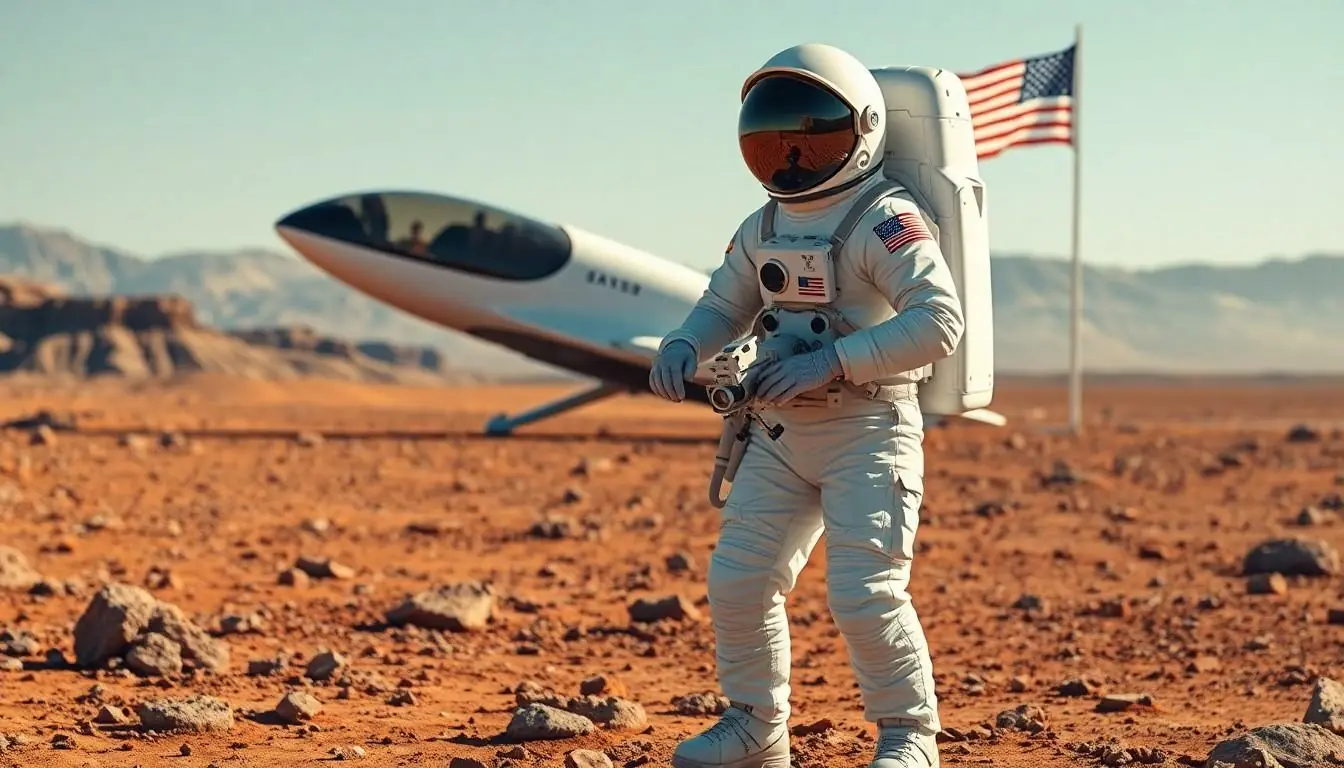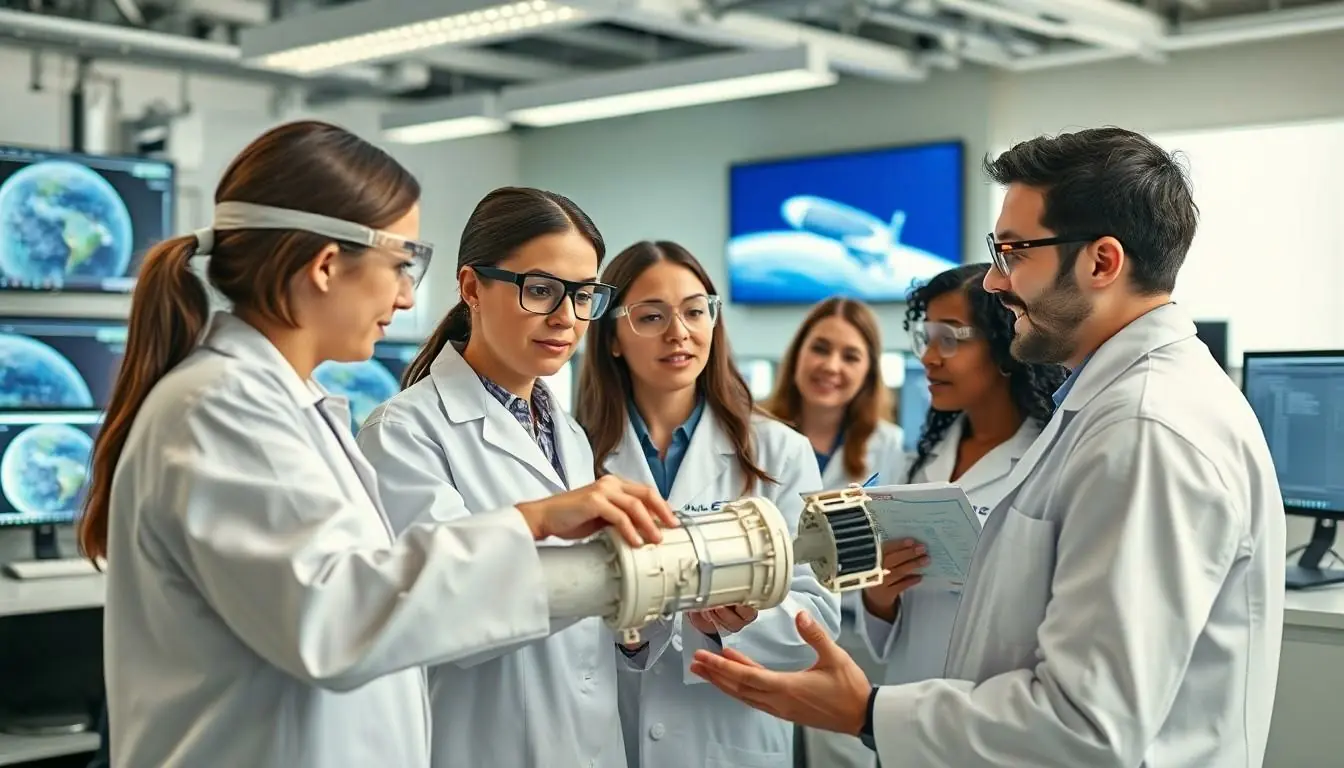Space technology isn’t just for rocket scientists anymore. It’s the secret sauce behind everything from satellite navigation to the latest smartphone features. Imagine trying to find your favorite taco spot without GPS—chaos, right? That’s where space tech swoops in like a superhero, turning the vastness of the cosmos into a playground of innovation.
Table of Contents
ToggleSpace Technology Definition Overview
Space technology consists of the tools, systems, and techniques used to explore, understand, and utilize outer space. This area encompasses advancements in spacecraft design, satellite systems, and launching technologies. Technologies like rocketry support missions beyond Earth’s atmosphere.
Various components form the basis of space technology. Satellites, for example, aid in communication, weather forecasting, and global positioning systems. Advances in computer systems enhance data processing and mission control. Robotics play a significant role in tasks like planetary exploration, with rovers collecting data on Mars.
Multiple sectors benefit from the applications of space technology. Agriculture relies on satellite imagery for monitoring crop health and predicting yields. Transportation navigation improves through precise satellite signals, facilitating logistics and route optimization. Telecommunications thrive with satellite networks, enabling global connectivity.
Significant investments drive the development of space technology. Governments and private companies both contribute to funding research and innovation. Collaborations between organizations often lead to breakthroughs that extend beyond space exploration. The utility of space tech influences economic growth and enhances quality of life.
Space technology entails an array of tools and methods that have substantial implications across numerous fields. By continuing to evolve, these technologies reaffirm their value in addressing contemporary challenges.
Key Components of Space Technology

Space technology comprises various crucial components that enable the exploration and utilization of outer space effectively.
Satellites
Satellites play a vital role in space technology. They facilitate communication, weather forecasting, and Earth observation. For instance, GPS satellites provide precise navigation, essential for everyday activities like driving to a location. Earth observation satellites gather data for climate research and disaster management. The advancements in satellite technology enhance data collection and improve connectivity across regions. Notably, small satellites, like CubeSats, offer cost-effective solutions for scientific missions, expanding access to space for numerous organizations.
Launch Vehicles
Launch vehicles are integral to transporting payloads into space. These rockets carry satellites and spacecraft beyond Earth’s atmosphere. Each launch vehicle varies in payload capacity and mission trajectory. For example, the SpaceX Falcon 9 offers reusable technology, significantly reducing costs for commercial missions. Additionally, heavy-lift launch vehicles like the Ariane 5 support larger missions, carrying multiple satellites simultaneously. Innovations in launch vehicle technology contribute to more frequent and reliable space missions, driving progress in the industry.
Spacecraft
Spacecraft encompass various vehicles designed for space travel and exploration. Rovers, probes, and crewed spacecraft serve specific purposes, enabling research and planetary exploration. Rovers, like NASA’s Perseverance, gather data on planetary surfaces, enhancing scientific understanding. Probes travel beyond Earth’s orbit to study celestial bodies and phenomena. Crewed spacecraft, such as the Orion capsule, enable human exploration of space. The integration of advanced technology in spacecraft design improves safety and functionality, leading to mission success and greater achievements in space exploration.
Applications of Space Technology
Space technology is integral to various fields, enhancing capabilities and improving daily life dramatically.
Communication
Satellites play a crucial role in communication, enabling global connections for individuals and businesses alike. These communication satellites facilitate telephone, internet, and broadcasting services, overcoming geographical barriers. Innovations in satellite technology have improved bandwidth and connectivity, allowing streaming services and video conferencing to flourish. Major corporations, including SpaceX and Intelsat, have invested heavily in satellite networks to enhance communication infrastructure further. As demand for connectivity continues to rise, the development of low-Earth orbit satellites promises faster and more reliable services.
Earth Observation
Earth observation utilizes satellite technology to monitor environmental changes and natural disasters. Satellites equipped with sensors gather data on climate patterns, deforestation, and urbanization. This information supports decision-making in agriculture, disaster management, and urban planning. Organizations like NASA and ESA (European Space Agency) deploy satellites to provide critical data for scientific research and policy-making. Remote sensing technology enhances capabilities to track land and water management effectively, improving sustainability efforts globally. Through accurate monitoring, the technology facilitates timely responses to natural disasters, potentially saving lives.
Scientific Research
Scientific research benefits significantly from space technology, advancing knowledge in multiple areas. Satellites facilitate astronomical observations, discovering new celestial bodies and phenomena. Space missions also gather fundamental data on planetary atmospheres, geology, and potential for life beyond Earth. Instruments aboard spacecraft like the Hubble Space Telescope and Mars rovers contribute essential findings that shape our understanding of the universe. Collaborations among space agencies encourage data sharing and joint missions, promoting international scientific efforts. The ongoing exploration deepens humanity’s understanding of physics, biology, and geology, paving the way for future innovations.
The Importance of Space Technology
Space technology plays a significant role in modern society, influencing various aspects of daily life and overall development.
National Security
National security relies heavily on advances in space technology. Satellites monitor potential threats, facilitating real-time intelligence gathering. High-resolution imagery assists in surveillance and reconnaissance, enhancing military operations. Additionally, GPS technology supports navigation for defense resources, ensuring strategic movements are accurate and efficient. Enhanced communication systems provide secure channels for military operations, decreasing vulnerability to cyber threats. Given these capabilities, governments increasingly invest in satellite systems and space-based assets to safeguard national interests and deter adversaries.
Economic Growth
Economic growth benefits substantially from innovations in space technology. The satellite industry contributes billions to global economies, promoting job creation across various sectors. Technologies developed for space exploration often find applications in telecommunications, healthcare, and environmental monitoring. For instance, satellite imagery aids in agricultural productivity, optimizing resource allocation and boosting yields. Startups continue to emerge in the space sector, fostering competition and attracting investments from private enterprises. Policymakers recognize the potential of space technology to drive technological advancement, leading to increased collaboration between governments and private companies.
Future Trends in Space Technology
The future of space technology promises exciting developments across various areas. Innovations in propulsion systems and advancements in satellite technology stand out.
Innovations in Propulsion
New propulsion systems are set to revolutionize space travel. Electric propulsion methods, such as ion thrusters, offer increased efficiency for long-duration missions. These systems enable spacecraft to travel farther with less fuel. In addition, advancements in nuclear thermal propulsion could significantly reduce travel time to destinations like Mars. Hybrid systems combining traditional and new methods provide versatile options for exploration. Spacecraft equipped with these cutting-edge propulsion technologies enhance mission capabilities and expand exploration horizons. Future missions to the outer planets or beyond benefit immensely from these innovations.
Advancements in Satellite Technology
Satellite technology continues to evolve rapidly. Miniaturization allows for the development of small satellites, often referred to as CubeSats, which reduce launch costs and increase accessibility. These small satellites serve diverse applications, ranging from Earth monitoring to scientific research. Additionally, innovations in satellite networks, such as low Earth orbit constellations, promise global internet coverage. Advanced sensors and imaging capabilities enhance data collection for various sectors. Collaborative initiatives drive the integration of artificial intelligence, improving satellite operations and decision-making processes. Future developments in satellite technology will play a crucial role in connecting people and improving environmental monitoring worldwide.
Space technology is reshaping the way society functions by integrating advanced tools and techniques into everyday life. Its influence spans various sectors from agriculture to national security, driving innovation and enhancing efficiency. As investments in this field continue to grow, the potential for breakthroughs remains vast.
Future advancements in propulsion systems and satellite technology promise to further revolutionize space exploration and connectivity. The ongoing collaboration between governments and private entities is crucial for fostering this growth. Ultimately, space technology not only addresses current challenges but also paves the way for a more connected and sustainable future.

